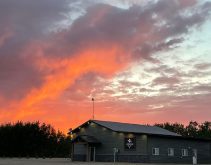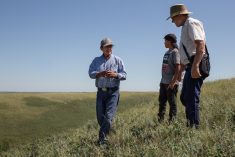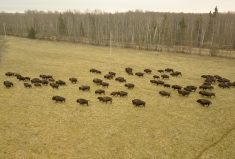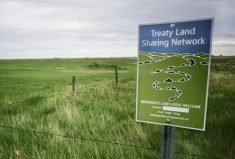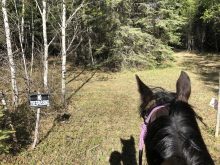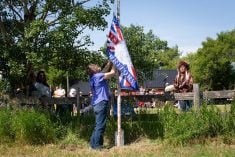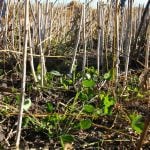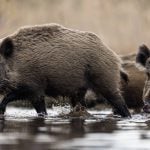This is the second in a multi-part series. Read the first story here.
It started out much like any other winter day, as Phil hauled in wood to heat his home. But then he heard the rumble of snowmobiles. He could tell they were on his land, even though it was posted with “No-Trespassing” signs. He thought about the lame moose sheltering on his land, and worried they were harassing her.
Read Also
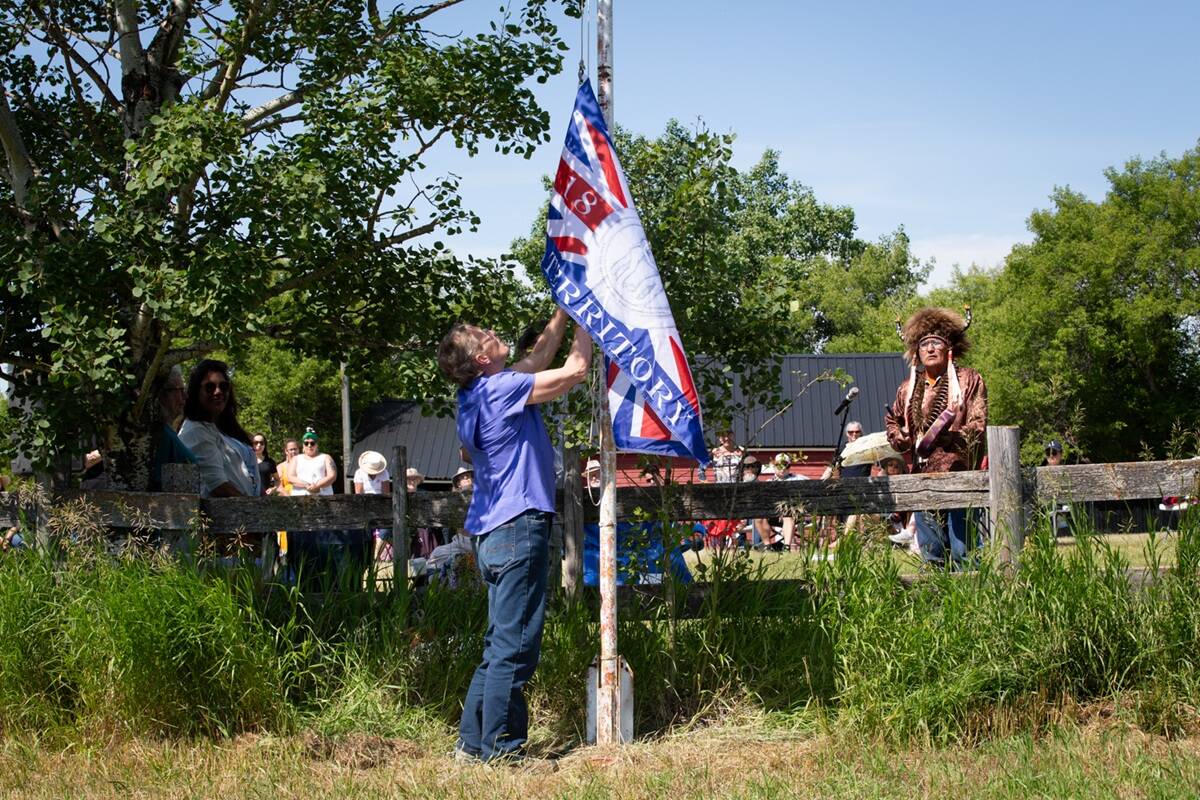
Treaty Land Sharing Network expands reach in Saskatchewan and Alberta
The Treaty Land Sharing Network, which connects land holders with First Nations and Metis people, has expanded since it began in 2018
He headed out to confront them, carrying a short-barreled shotgun he kept on hand in case of aggressive bears or, that winter, dog packs roaming the area, he says. Phil’s house is shielded by bush, but between the bush and the grid road is a small hayfield where the snowmobilers were revving up their machines. By the time he got there, one of the snowmobilers had taken off, but the other was still plunging through drifts. Carrying his shotgun, Phil confronted the man, using some “foul language,” he says. The snowmobiler had a phone with a camera and snapped a photo or video of Phil carrying the gun, then reported the confrontation to the local RCMP. The next day, the RCMP arrested Phil.
Phil has forgotten some of the details of the charges in the nine or so years since the confrontation. But from what he recalls, he was charged with uttering threats as well as firearm offences (and that matches my own memory at court). The snowmobilers weren’t charged with trespassing, as far as he knows, even though the land was posted. He suspects they came back to his property shortly after the confrontation, something he thinks helped him in court.
It’s easy to write off this incident as a hot-headed landowner getting carried away. But it reveals the biggest risk that lurks on the edge of all these encounters — is someone going to get hurt, or worse?
Not every encounter over trespassing is this dramatic. But from the landowner’s perspective, snowmobilers are wearing helmets that make them hard to identify, at least until they take them off to talk to you. They may be people you know, or they may be strangers. They’re often in groups, which can be intimidating for a landowner who is confronting them alone. And snowmobiles and ATVs can go places other vehicles can’t follow, with snowmobiles being especially fast. If you ask around any rural community like this, people will have stories of tense encounters with strangers trespassing on their property or someone else’s.
Some people who want to access the land fear confrontation, too. When I ask Autumn Baptiste whether they hunt on private land, she says they stick to their First Nation’s community lands because they’re scared to cold-call landowners. Autumn’s mother hails from Thunderchild/ Piyesiw-Awasis First Nation, a reserve in my community. But her father is from Red Pheasant/Mikisiwacîhk First Nation Saskatchewan, a place that will sound familiar to anyone who followed the Gerald Stanley trial. Colten Boushie, the young man who was shot and killed by Gerald Stanley during a confrontation, was her cousin.
Colten was a 22-year-old from Red Pheasant. On an August day in 2016, he and four friends were driving around the area in an SUV. They pulled into the Stanley farmyard. A confrontation followed with Gerald Stanley and his son, Sheldon, who smashed the SUV’s windshield with a hammer. At one point, Gerald grabbed a handgun and fired a couple of shots. The driver of the SUV fled, and Colten, who had been in the back, jumped into the driver’s seat. Gerald then shot Colten behind the ear at close range, killing him. He was charged with second-degree murder and manslaughter, but ultimately acquitted.
Those are the barest of facts that I think everyone can agree on (maybe). One side says Colten and his friends pulled into the Stanley yard looking for help with a flat tire, did not provoke the conflict and that Colten was trying to leave right before he was shot. The other side says they were drunk and were trying to take an ATV from the Stanleys’ yard before the shooting, the first two shots were warning shots and that the fatal shot was accidental. The Civilian Review and Complaints Commission, the national watchdog for the RCMP, found issues with the police investigation ranging from evidence handling (not calling a blood spatter expert to the scene and leaving the SUV uncovered, which allowed rain to wash away evidence) to how RCMP broke the news to Colten’s mother. There are many other details, interpretations of, and opinions on, what exactly happened.
I don’t think it’s possible to disentangle the Gerald Stanley case from conversations about racism and rural policing in Saskatchewan. But a shooting in rural Alberta from years earlier holds some similarities. In June 1999, Karman Willis was shot while allegedly joyriding with her friends at the Trickle Creek Farm near Hythe, in northern Alberta. Karman was one of eight teenagers, in two trucks, who arrived at the commune at 4 am after a bush party.
Just like the Stanley-Boushie tragedy, an us vs. them mentality quickened at Hythe. Trickle Creek was home to Wiebo Ludwig, a former Christian Reformed minister, his family and followers. Before the shooting, there was already tension between Trickle Creek and its neighbours over Wiebo’s vocal opposition to — and suspected vandalism of — natural gas projects. He would later be convicted for his part in bombing a Suncor well.
When it came to what happened at Trickle Creek that morning, narratives diverged widely. Wiebo said the teens were drunk, throwing beer bottles and driving close to children sleeping in tents on the property. Some of the other teens present said they were sober, simply curious and on their way out when the shooting started. One teen was hit and spent three days in the hospital before being discharged. Karman, 16 years old at the time, was not so lucky. She was shot in the chest and died from her injuries. No one was charged for her death, feeding the community’s rage, and some residents threatened vigilante action.
I remember the conversations around this event clearly — speculation about what exactly happened, who at the commune shot Karman, whether they did it out of fear or anger and whether they meant it as a warning shot or intended harm.
References to bush parties were instantly familiar to me, as a northern Saskatchewan kid. As a (sometimes less-than-angelic) teen myself in 1999, I spent a lot of time driving around with my friends on rural roads. I wondered what I would do if I found myself in a truck being driven somewhere I didn’t want to go. I wondered if Karman encouraged the driver, whether she tried to talk him into turning around, or whether she was silent. Again, there are differences between Karman and Colten’s stories, but like Karman, Colten was a passenger when his friend drove the SUV into the Stanleys’ farmyard. I wonder what the dynamics were within Colten’s friend group, too.
I wonder how often snowmobilers or ATV enthusiasts find themselves blindly following the group leader onto private property, and only realize once they’re being confronted by an angry landowner that they’re somewhere they shouldn’t be.
I’d like to write that I hope Western Canada doesn’t see another shooting death like Colten’s, but we already have. Roger and his son, Anthony Bilodeau, were recently convicted of manslaughter for the deaths of Maurice Cardinal and Jacob Sansom in northeastern Alta. The Bilodeaus said that they believed Maurice and Jacob had been on the family farm with their truck earlier in the day, for some nefarious purpose (a belief the trial judge characterized as an “unfounded conclusion”). They chased the Metis men at high speed, until Anthony eventually shot them, one at a time, on a rural road. Then the father and son left the scene, not calling the police or ambulance. Roger was sentenced to 10 years, and Anthony’s sentencing is slated for November.
Autumn and I talk about not wanting to inflame existing tensions while having this type of conversation. While she’s critical of Saskatchewan’s recent changes to trespassing legislation, she agrees with the principle of asking permission before accessing property, partly for everybody’s safety. But the fact that people are afraid to even ask says a lot about the situation in this province.
It’s something Phil has thought about, too, in the years since his case concluded with a small fine and the loss of his shotgun.
“I think it’s going to get worse before it gets better.”
Read the next chapters here:




